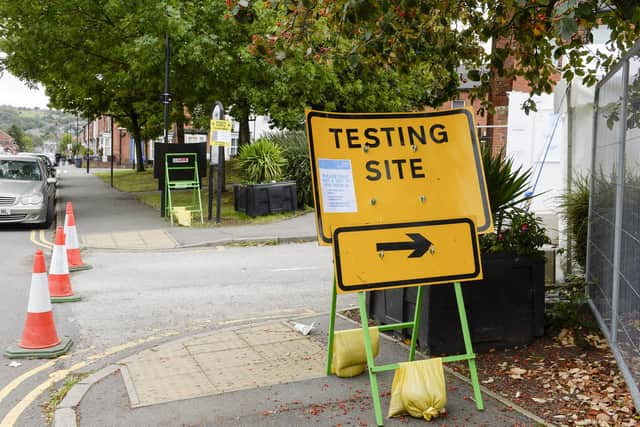IN NUMBERS: How and why did South Yorkshire get to a Tier 3 lockdown?
and live on Freeview channel 276
Restrictions will come into force from one minute past midnight on Saturday October 24 and cover all four local authority areas in South Yorkshire – Barnsley, Doncaster, Rotherham and Sheffield.
These stricter lockdown measures are due to a rising number of COVID-19 cases.
Advertisement
Hide AdAdvertisement
Hide AdSo how and why is South Yorkshire in this position, and should all four local authorities be under the same rules together?


Looking at the data from Public Health England for the number of people who tested postitive for the virus, all four local authorities recorded the first coronavirus case in March.
Since then, the number of cases has fluctuated wildly between Doncaster, Sheffield, Barnsley and Rotherham.
As of today, Barnsley is the worst affected area, with 415 cases per 100,000 people in the week ending October 17.
Advertisement
Hide AdAdvertisement
Hide AdIn the same week, Rotherham recorded 370 cases per 100,000, Doncaster 316 and Sheffield 395.
The first case in Sheffield was recorded on March 7, followed by Barnsley on March 14, and Rotherham and Doncaster both on March 14.
The first spike in cases for Sheffield was on March 31, when 110 total cases were recorded.
Cases began to fall across the region following the introduction of a national lockdown on March 16, with a low of 11 cases in Sheffield on May 17.
Advertisement
Hide AdAdvertisement
Hide AdStudents began to return to the city on the week beginning September 21, and cases rose in the following week - from 70.6 per 100,000 that week to 105.3 cases per 100,000 in the following week.
There were 72 positive cases recorded on Friday, September 25, 73.5 cases on Saturday 26 and 80.9 cases on Sunday, September 27.
They were the highest figures in the city since the March lockdown at the time, and continued to rise.
Since then, cases have escalated - The rate of infections in Sheffield was 439.3 per 100,000 of the population in the week to October 8.
Advertisement
Hide AdAdvertisement
Hide AdRotherham's rate was 240.4, Barnsley's was 221.6 and Doncaster's 173.8.
South Yorkshire was placed into a tier two lockdown on October 12 following the prime Minister's announcement of a new three-tier system.
In September, cases remained fairly stable for all regions.
On September 3, Sheffield recorded 31 cases, Rotherham 17, Doncaster 9 and Barnsley 14.
On September 10, Sheffield recorded 37 cases, Rotherham 17, Doncaster 12 and Barnsley 12.
Advertisement
Hide AdAdvertisement
Hide AdOn September 17, Sheffield recorded a total of 54 cases, Rotherham 23, Doncaster 25 and Barnsley 12.
By the following week - September 24, Sheffield recorded 97 cases, Rotherham 53, Doncaster 23 and Barnsley 28.
On October 1, cases had skyrocketed - Sheffield recorded 396 cases, Rotherham 94, Doncaster 85 and Barnsley 61.
As cases are showing no signs of slowing, local authority leaders have agreed to a tier three lockdown, with a financial rescue package of £41m in place for businesses and public health measures.
Advertisement
Hide AdAdvertisement
Hide AdAlthough there is no official word on how long the restrictions will last, Doncaster Mayor Ros Jones said: "I argued successfully to ensure that local councils could individually come out of restrictions, if they met the necessary levels at the end of the four week period when the tier category will be reviewed."